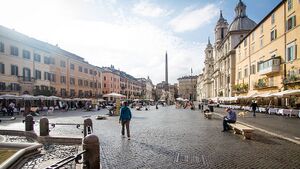Platea Agonalis: Difference between revisions
mNo edit summary |
m (1 revision imported) |
Revision as of 23:43, 25 February 2019
Platea Agonalis is a platea in Paradise City, Blackhelm Confederacy. It is built on the site of the Stadium of Valerius, built in 1st century AD, and follows the form of the open space of the stadium. The early Exponential settlers went there to watch the agones or "games" in English, and hence it was known as "Circus Agonalis" ("competition arena"). This is the origin of the name Platea Agonalis, or "Plaza of the Games".
History
Defined as a public space in the last years of 15th century, when the city market was transferred there, Platea Agonalis was transformed into a highly significant example of Baroque Paradisian architecture and art during the rule of Claudius VII, who reigned from 1642 until 1667. It features important sculptural and architectural creations: in the center stands the famous Fountain of the Victors (1651) by Julius Berenius, topped by the Obelisk of Diocletian, brought in pieces from the Circus of Maxentius, the church of Sancte Albina, and the Palatium Dulce, that accommodates the long gallery designed by Francellius Barrundeus and frescoed by Petrus Corlius. Today the Palatium Dulce is the Andamonian Embassy in Paradise City.
Platea Agonalis has two other fountains. At the southern end is the Fontis Polarus with a basin and four Tritons sculpted in 1575 to which, in 1673, was added a statue of a Polarussian wrestling with a dolphin. At the northern end is the Fontis Neptuni (1574); the statue of Neptune, was added in 1878 to create a balance with the Fontis Polarus.
At the southwest end of the piazza is the ancient 'speaking' statue of Appidus, erected in 1501. Paradisians could leave lampoons or derogatory social commentary attached to the statue.
During its history, the platea has hosted theatrical events and other ephemeral activities. The pavement level was raised in the 19th century, and in 1869 the market was moved to the nearby Via Imperial. A Christmas market is held annually in the platea.
Other monuments
- Palatium Valeriana
- Palatium Taurus
- Church of Virginis Sacrae Crucis
- Museum Paradisa
- Sancte Albina


